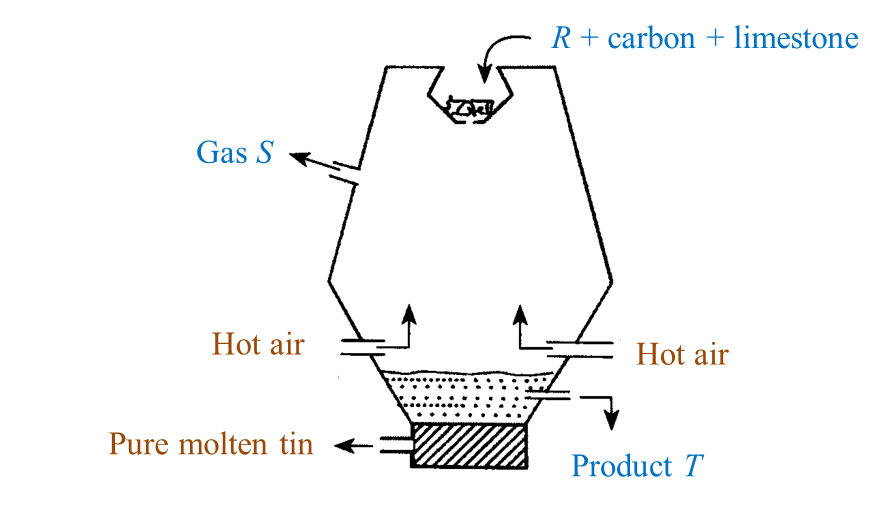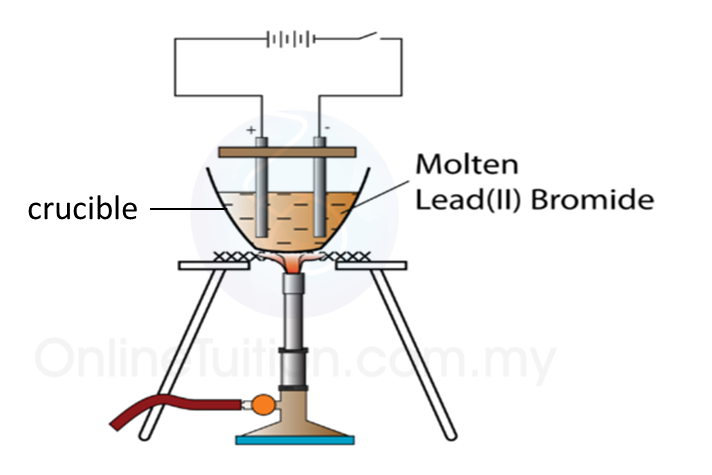SPM Science
6.1(A) The composition of the Nucleus
(A) The Composition of the Nucleus

Stability of Nucleus
The nucleus becomes unstable if it has too many protons, too many neutrons or too much
energy.
energy.
Radioactive Decay
1. The unstable nucleus will decay to release radioactive radiation.
2. Radioactivity is the spontaneous process of an unstable nucleus emitting radioactive
emission in order to become more stable.
emission in order to become more stable.
6.1 Radioactive Substances
6.1 Radioactive Substances
1. Radioactive substances are substances with unstable nuclei in their atoms. Unstable nuclei will decay and emit radioactive radiation.
2. Examples of radioactive substances are:
(a) Carbon-14
(b) Cobalt-60
(c) Iodine-131
(d) Uranium
(a) Carbon-14
(b) Cobalt-60
(c) Iodine-131
(d) Uranium
5.9.4 Electrolysis (Structured Questions)
Question 1:
Diagram 1 shows the setting up of apparatus in an experiment.
 (a) Name the process in Diagram 1. [1 mark]
(a) Name the process in Diagram 1. [1 mark]
(b)(i) Name metal Q. [1 mark]
(ii) What happens to metal Q during the process in Diagram 1? [1 mark]
(c) Which metal functions as the cathode? [1 mark]
(d)(i) What will happen to the iron key at the end of the experiment? [1 mark]
(ii) State one method to get a good result in (d)(i) [1 mark]
Answer:
(a) Electroplating
(b)(i) Copper
(b)(ii) Metal Q dissolves in the copper(II) sulphate solution to form copper ions and becomes thinner.
(c) Iron key.
(d)(i) The surface of the iron key will be coated with a brown layer of copper.
(d)(ii) The surface of the metal to be plated must be cleaned with sandpaper before electrolysis begins.
Diagram 1 shows the setting up of apparatus in an experiment.
 (a) Name the process in Diagram 1. [1 mark]
(a) Name the process in Diagram 1. [1 mark](b)(i) Name metal Q. [1 mark]
(ii) What happens to metal Q during the process in Diagram 1? [1 mark]
(c) Which metal functions as the cathode? [1 mark]
(d)(i) What will happen to the iron key at the end of the experiment? [1 mark]
(ii) State one method to get a good result in (d)(i) [1 mark]
Answer:
(a) Electroplating
(b)(i) Copper
(b)(ii) Metal Q dissolves in the copper(II) sulphate solution to form copper ions and becomes thinner.
(c) Iron key.
(d)(i) The surface of the iron key will be coated with a brown layer of copper.
(d)(ii) The surface of the metal to be plated must be cleaned with sandpaper before electrolysis begins.
5.9.3 Application of Reactivity Series of Metals (Structured Questions)
Question 1:
Diagram below shows the extraction of tin ore at high temperature in a blast furnace.

(a) Name two elements in R. [2 marks]
(b) State one reason why carbon is a suitable element to use in the extraction of tin ore from R? [1 mark]
(c) Name gas S. [1 mark]
(d) What is the function of limestone in this process? [1 mark]
(e) Name product T. [1 mark]
Answer:
(a) Tin, oxygen
(b) As tin is less reactive than carbon, carbon can be used to reduce the tin ore from R.
(c) Carbon dioxide.
(d) The limestone is decomposed to produce quicklime (calcium oxide) which combines with impurities such as silica to form slag.
(e) Slag
Diagram below shows the extraction of tin ore at high temperature in a blast furnace.

(a) Name two elements in R. [2 marks]
(b) State one reason why carbon is a suitable element to use in the extraction of tin ore from R? [1 mark]
(c) Name gas S. [1 mark]
(d) What is the function of limestone in this process? [1 mark]
(e) Name product T. [1 mark]
Answer:
(a) Tin, oxygen
(b) As tin is less reactive than carbon, carbon can be used to reduce the tin ore from R.
(c) Carbon dioxide.
(d) The limestone is decomposed to produce quicklime (calcium oxide) which combines with impurities such as silica to form slag.
(e) Slag
5.9.2 The Reactivity Series of Metals (Structured Questions)
Question 1:
Diagram 1.1 and Diagram 1.2 show an experiment to study the reactivity of metals with water.

(a) Observe Diagram 1.1. State the volume of gas collected.
Write down your answer in Table below. [1 mark]

(b) Based on the result in Table above, state one inference. [1 mark]
(c) State the variables in this experiment.
(i) Constant variable [1 mark]
(ii) Responding variable [1 mark]
(d) Based on this experiment, mark (\/) the metal which is more reactive. [1 mark]
Answer:
(a)

(b) A reactive metal can displace more gas from water.
(c)(i) The mass of the metal / The time taken
(c)(ii) The volume of gas collected
(d)
Diagram 1.1 and Diagram 1.2 show an experiment to study the reactivity of metals with water.

(a) Observe Diagram 1.1. State the volume of gas collected.
Write down your answer in Table below. [1 mark]

(b) Based on the result in Table above, state one inference. [1 mark]
(c) State the variables in this experiment.
(i) Constant variable [1 mark]
(ii) Responding variable [1 mark]
(d) Based on this experiment, mark (\/) the metal which is more reactive. [1 mark]
Answer:
(a)

(b) A reactive metal can displace more gas from water.
(c)(i) The mass of the metal / The time taken
(c)(ii) The volume of gas collected
(d)
5.9.1 Heat Change in Chemical Reactions (Structured Questions)
Question 1:
Diagram 1.1 and Diagram 1.2 show an experiment to study the heat change in chemical reactions at room temperature.

(a) Based on Diagram 1.1, what is your observation about the change in temperature?
Mark (\/) for your answer in Table below. [1 mark]

(b) What is the final reading for the thermometer in Diagram 1.2? [1 mark]
(c) State the variables in this experiment.
(i) Constant variable [1 mark]
(ii) Responding variable [1 mark]
(d) State one hypothesis for this experiment. [1 mark]
Answer:
(a)

(b) 35 oC
(c)(i) The amount of water or initial temperature
(c)(ii) The final temperature
(d) In a chemical reaction, heat is given out causing a rise in temperature or is absorbed causing a drop in temperature.
Diagram 1.1 and Diagram 1.2 show an experiment to study the heat change in chemical reactions at room temperature.

(a) Based on Diagram 1.1, what is your observation about the change in temperature?
Mark (\/) for your answer in Table below. [1 mark]

(b) What is the final reading for the thermometer in Diagram 1.2? [1 mark]
(c) State the variables in this experiment.
(i) Constant variable [1 mark]
(ii) Responding variable [1 mark]
(d) State one hypothesis for this experiment. [1 mark]
Answer:
(a)

(b) 35 oC
(c)(i) The amount of water or initial temperature
(c)(ii) The final temperature
(d) In a chemical reaction, heat is given out causing a rise in temperature or is absorbed causing a drop in temperature.
5.5.3 Electrolysis of Molten lead (II) bromide
5.5.3 Electrolysis of Molten lead (II) bromide

1. Figure above shows the apparatus set up for electrolysis of molten lead (II) bromide.
2. Lead (II) bromide powder in a crucible is heated.
3. The electrolysis process start when le an (II) bromide start melting.
4. At the Cathode
When electricity is flowing, a silvery deposit of lead metal forms on the cathode.
5. At the Anode
When electricity is flowing, brown fumes of bromine gas are seen at the anode.
Explanation:

6. Thus, electrolysis of lead (II) bromide produces lead and bromine gas.
5.5.2 Electrolysis of Copper (II) Chloride Solution
5.5.2 Electrolysis of Copper (II) Chloride Solution

1. Electrolysis of copper (II) chloride solution.
(a) Copper (II) ion with positive charge will attract to cathode to discharge as a copper.
(b) Chloride ion will attract to anode to discharge as a chlorine gas.
(c) At anode, chloride ions lose electrons. Greenish gas which can bleach the litmus paper is produced.
(d) At cathode, copper (II) ion receives electron. Brown solid deposited on the surface of the electrode.

2. Thus, electrolysis of copper (II) chloride produces copper and chlorine gas.
5.5 Electrolysis
5.5 Electrolysis
5.5.1 Electrolysis
1. Electrolysis is a process where a compound is separated into its constituent elements when electric current passes through an electrolyte.
2. In electrolysis, energy is changed as shown below:
3. The apparatus used in an electrolytic cell consists of a dry cell or battery, an electrolyte and two electrodes as shown below.


Electrolytic cell
Electrolyte
(a) An electrolyte is a compound in a molten form or in aqueous solution which conducts electric current.
(b) Electrolyte contains two types of charged ions which move freely:
(i) Ion with positive charge (cation), for example, metal ions and hydrogen ions.
(ii) Ion with negative charge (anion), for example, non-metal ions.
(i) Ion with positive charge (cation), for example, metal ions and hydrogen ions.
(ii) Ion with negative charge (anion), for example, non-metal ions.
(c) Example of electrolyte: molten potassium chloride and hydrocloric acid.
Electrode
(a) Electrode is a conductor which is immersed in an electrolyte and connected to an electric source.
(b) Examples of electrode: carbon (graphite) and platinum.
(c) The electrode connected to the positive terminal of the cell is positive electrode and is given a name, anode.
(d) The electrode connected to the negative terminal of the cell is negative electrode and is called the cathode.
Ammeter
Ammeter is used to detect the flow of current in the circuit.
Dry cell or battery
The source that generates electrical energy.


